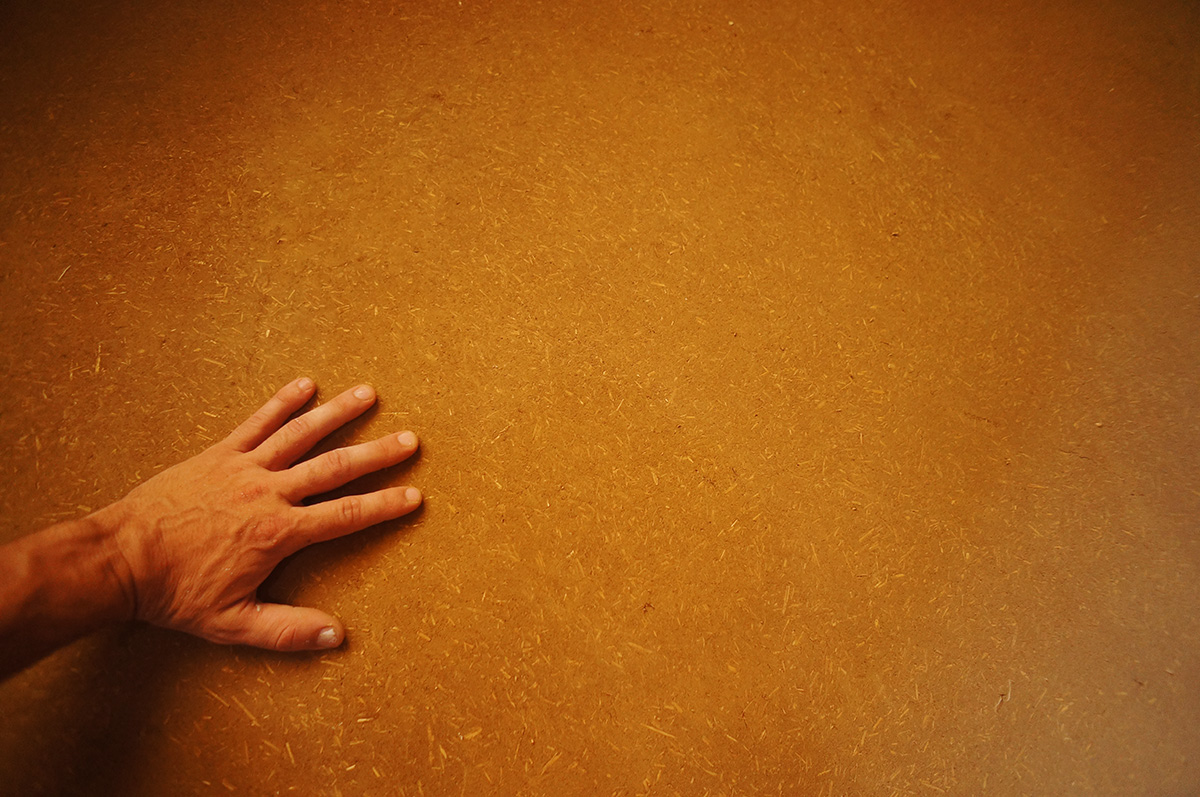Earthen floors are floors composed of compacted clay, sand, and straw. They are made flat and troweled smooth just like a concrete slab. However, the finished product is much softer on your feet… and on the earth itself. You can build an earthen floor with readily available materials. The labor input is quite high, but the material cost should be very low. And of course, the embodied energy is low, too — this is a very resilient, low tech method that can be incorporated in a variety of locales. Here’s a very short introduction and answers to common questions about earthen floors.
Where can I install an earthen floor?
 Earthen floors can be installed in new construction, either over a compacted gravel subfloor or even a concrete slab. You might be surprised to learn that earthen floors can also be installed on a wood subfloor if you take some special precautions. That means many existing conventional homes are a possible candidate for an earthen floor retrofit.
Earthen floors can be installed in new construction, either over a compacted gravel subfloor or even a concrete slab. You might be surprised to learn that earthen floors can also be installed on a wood subfloor if you take some special precautions. That means many existing conventional homes are a possible candidate for an earthen floor retrofit.
What are earthen floors made of?
Earthen floors are made of clay subsoil, sand, and straw in varying proportions. Basically, on a micro-scale, the sand particles are your aggregate and provide the compressive strength of the floor. The clay is a binder which forms a matrix and binds every particle of sand together. The abundant straw is like millions of pieces of tiny rebar, giving the whole structure lots and lots of tensile strength. Your recipe and proportions will depend on exactly what type of soil you have available, but a 3:1 sand/clay ratio is common.
If you’re building an earthen floor base layer, you can use less fine material and lots and lots of straw in varying lengths. The finish layer of an earthen floor should have finer particle sizes of sand and clay, and chopped straw, and you can even add cow manure for added fiber content.
Are earthen floors durable?
 Earthen floors are indeed quite hard and durable, but let’s be clear that they are NOT concrete. What I mean is that earthen floors are more susceptible to certain kinds of damage, including point loads and scraping. Think of a chair leg dragging across the surface — that could result in surface damage unless the chair leg is padded. Very heavy point loads can leave indentations in the floor over a sustained period of time as well. Of course, you would not want to leave water or wet items in contact with the floor for very long either. Some reasonable and simple precautions should prevent most of the potentials for damage.
Earthen floors are indeed quite hard and durable, but let’s be clear that they are NOT concrete. What I mean is that earthen floors are more susceptible to certain kinds of damage, including point loads and scraping. Think of a chair leg dragging across the surface — that could result in surface damage unless the chair leg is padded. Very heavy point loads can leave indentations in the floor over a sustained period of time as well. Of course, you would not want to leave water or wet items in contact with the floor for very long either. Some reasonable and simple precautions should prevent most of the potentials for damage.
Can earthen floors be easily cleaned?
Earthen floors are made water resistant when they are sealed with oil (typically linseed oil). Also, linseed oil has a hardening effect, which means the floor should not dust at all once it is cured. In effect, that means you’ll be able to sweep just like you would any other floor surface, and occasional light mopping is also possible.
Ok, what are some other benefits?
One of the main benefits of an earthen floor is the feeling of the surface itself. It’s amazing how soft to the touch they are. Have you ever stood on a concrete floor for more than a few minutes? The answer is likely yes, and the physical toll it takes on your body is significant after enough time. No such thing with an earthen floor.
Earthen floors also represent a very low tech, low embodied energy method that is applicable in a wide variety of settings. Few manufactured tools or products are essential to making one. They’re highly compatible with in-floor radiant heat, and they’re a great feature in passive solar homes — they can absorb heat from the winter sunshine, and help keep a home cool in the summer if designed properly. The cost, especially if you can do the labor yourself, is very low as well.
Sounds good. Where can I learn more?
In the near future, I’ll post a little more in-depth information on how to install your own earthen floor. I’ll provide a link here when I do so. I also recommend checking out this book, Earthen Floors by Sukita Reay Crimmel and James Thomson. It’s a nice primer and it clearly illustrates the building process.



Thank you! Very interested in learning more about earthen floors on a wooden or raised floor!